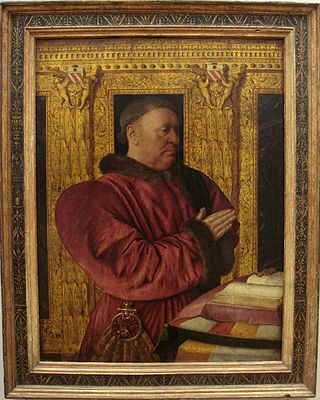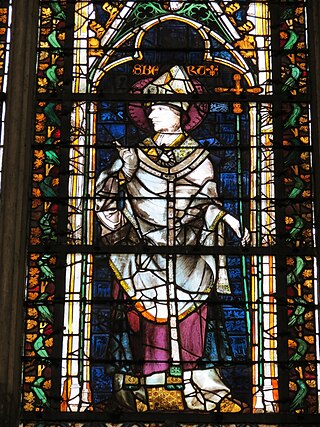
Year 695 (DCXCV) was a common year starting on Friday of the Julian calendar. The denomination 695 for this year has been used since the early medieval period, when the Anno Domini calendar era became the prevalent method in Europe for naming years.
Category, plural categories, may refer to:

Wastewater is water generated after the use of freshwater, raw water, drinking water or saline water in a variety of deliberate applications or processes. Another definition of wastewater is "Used water from any combination of domestic, industrial, commercial or agricultural activities, surface runoff / storm water, and any sewer inflow or sewer infiltration". In everyday usage, wastewater is commonly a synonym for sewage, which is wastewater that is produced by a community of people.

The Chancellor of France, also known as the Grand Chancellor or Lord Chancellor, was the officer of state responsible for the judiciary of the Kingdom of France. The Chancellor was responsible for seeing that royal decrees were enrolled and registered by the sundry parlements, provincial appellate courts. However, since the Chancellor was appointed for life, and might fall from favour, or be too ill to carry out his duties, his duties would occasionally fall to his deputy, the Keeper of the Seals of France.

A crow is a bird of the genus Corvus, or more broadly, a synonym for all of Corvus. The word "crow" is used as part of the common name of many species. The related term "raven" is not linked scientifically to any certain trait but is rather a general grouping for larger-sized species of Corvus.

February 8 - Eastern Orthodox liturgical calendar - February 10

Ansbert, sometimes called Ansbert of Chaussy, was a Frankish monk, abbot and bishop of Rouen, today regarded as a saint in the Catholic Church and Eastern Orthodox Church.

The Élysée Treaty was a treaty of friendship between France and West Germany, signed by President Charles de Gaulle and Chancellor Konrad Adenauer on 22 January 1963 at the Élysée Palace in Paris. With the signing of this treaty, Germany and France established a new foundation for relations, bringing an end to centuries of French–German enmity and wars.
Tonantius Ferreolus, was a vir clarissimus, or Gallo-Roman senator.

Ansbert was a Frankish Austrasian noble, as well as a Gallo-Roman Senator. He is thought to be the son of Ferreolus, Senator of Narbonne and his wife, Dode. This would make him the great-grandson of Tonantius Ferreolus, Praetorian Prefect of Gaul and his wife Papianilla.

Angadrisma was a 7th-century abbess and saint, daughter of Robert I, Bishop of Tours.

The Battle of Iconium took place on May 18, 1190, during the Third Crusade, in the expedition of Frederick Barbarossa to the Holy Land. As a result, Iconium, the capital city of the Sultanate of Rûm under Kilij Arslan II, fell to the Imperial forces.
World Wonder Ring Stardom, often referred to simply as Stardom, is a Japanese joshi puroresu or women's professional wrestling promotion based in Nakano, Tokyo, Japan. Stardom was founded in September 2010 by former All Japan Women's Pro-Wrestling (AJW) co-producer Rossy Ogawa, retired professional wrestler and mixed martial artist Fuka Kakimoto, and former AJW veteran professional wrestler Nanae Takahashi. Since June 2024, Stardom is a subsidiary of New Japan Pro-Wrestling (NJPW).
Chrodbert was a nobleman from Neustria. He was grandson to Chrodbert I, referendary to Clovis II through Chrodbert's son Lambert of Hesbaye. Chrodbert was Lord Chancellor during the reign of Chlothar III, King of the Franks in Neustria, as well as referendary. He was a contemporary of Ansbert of Rouen, who was also a Lord Chancellor to Clotaire III. Chrodbert was mentioned as Count palatine on 2 October 678.
Chrodebert I , Merovingian referendary, son of Charibert de Haspengau and his wife Wulfgurd. Robert and his brothers Erlebert and Aldebert were the ancestors of the Robertians.
The royal household of the early kings of the Franks is the subject of considerable discussion and remains controversial. This discussion is aimed at identifying the major categories of participants in the administration and those who made the major historical impacts. Every king of the Franks from Clovis I to Charles the Bald had a large cadre of advisors and bureaucrats that helped implement their regime. These supporters of the crown are frequently unknown, but often are ancestors of the later rulers of France. This is not intended to be a complete list of those supporting the kings but to serve as a guide for further study. A general discussion of the Merovingian and Carolingian dynasties can be found in the associated main articles. See also Government of the Carolingian Empire.
The History of the Expedition of the Emperor Frederick is an anonymous Latin account of the campaign waged by Frederick I, Holy Roman Emperor, as part of the Third Crusade. It covers the period 1187–1196, but is centred on the expedition of 1189–1190.
Saint Bain, a disciple of Saint Vandrille, was a bishop of Thérouanne in northwest France, and then abbot of the monastery of Saint Wandrille in Normandy. His feast day is 20 June.
Walbert I, Vaubert, Waudbert, or Vautier also known as Walbert of the Ardennes was a Frankish nobleman and a Merovingian Count of Hainaut.









